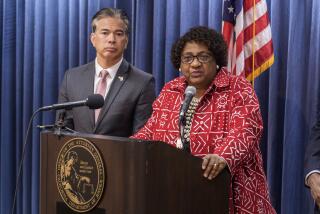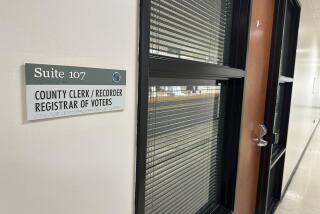FBI Traces Anthrax to N.J. Suburb
- Share via
EWING, N.J. — Teams of black-jacketed FBI agents questioned anxious residents along a tree-lined suburban postal route here Friday, and federal officials said they had found a mailbox where they suspect that at least one anthrax-laced letter began its journey.
As the federal probe picked up steam, the number of confirmed anthrax infections increased by two: a New York Post employee and a second New Jersey postal worker were added to the victim list, which has grown to eight people. The two new cases were skin infections, and the victims are being treated with antibiotics.
President Bush, addressing the anthrax incidents during remarks at an Asia-Pacific economic forum in Shanghai, said the U.S. government was responding “as quickly as possible” to treat those exposed to the bacteria and pledged that “ample supplies” of antibiotics would be available.
Dozens of FBI agents, organized into “evidence teams,” fanned out along the Ewing delivery route of a mail carrier who contracted cutaneous anthrax. The carrier may have handled the anthrax-contaminated letter sent to NBC News anchor Tom Brokaw in New York and possibly the letter sent to Senate Majority Leader Tom Daschle (D-S.D.) in Washington.
Many residents in the small suburban enclave just west of Trenton know the letter carrier as “Terry,” a mother in her mid-30s who had delivered along the route for about three years.
On Capitol Hill, meanwhile, new test results trimmed the official count of people exposed to anthrax there from 31 to 28. Elsewhere, traces of anthrax were found at two more postal facilities in Florida; the New York Times bureau in Rio de Janeiro received a letter postmarked from New York City with “bacteria or spores consistent” with anthrax; and authorities stepped up efforts to prevent anthrax-related hoaxes.
Thomas J. Ridge, the Bush administration’s new director of homeland security, told reporters in Washington that the FBI “has been able to identify the site where the letters were mailed.”
A Justice Department official who asked not to be identified said investigators were testing the suspect mailbox for anthrax and checking it for fingerprints. The test results were not yet back, the official said.
Investigators are treating the mailbox as “a possible link” to the person or persons responsible for the letters containing anthrax, the official said.
Officials would not identify the location of the mailbox. The letters to Daschle and Brokaw were postmarked Trenton, N.J., and the infected postal employees both worked in the working-class Ewing Township. Ridge noted that several hundred agents were assigned to the area to try to track down the source.
In Ewing’s Wynnewood Manor subdivision, a resident said that FBI officials had earlier pointed to a mailbox where they believed the letter to Brokaw was mailed Sept. 18.
Samantha Pae, 34, said she, her fiance, and her fiance’s mother were interviewed by FBI officers, who asked them how long they had lived in the area and whether they had noticed any suspicious activity or observed vehicles with out-of-state plates. The agents also asked them to provide their Social Security numbers, she said.
“They hit every house in the development area today,” she said, adding that she had not seen any strange people or unusual behavior. Charlotte Kaplan Piepszak, who has lived in the neighborhood for 30 years, said FBI agents asked similar questions of her.
“And then they asked if I knew any chemists,” she said.
An FBI official in Washington who asked not to be identified said investigators removed the suspected mailbox and were conducting tests to determine whether it was linked to the anthrax mailings.
Investigators were apparently led to the box as they explored the delivery route covered by the first infected mail carrier. The carrier delivered mail to several hundred residential addresses, officials said.
“She only picks up collections at homes,” Postal Service spokesman Ralph Stewart said. “She doesn’t touch the green relay boxes or the general blue collection boxes.”
Although FBI officials allowed television crews to accompany them as they went door to door to question Ewing residents, they were not sharing information with local officials, Ewing Mayor Alfred Bridges said.
Bridges told reporters he was “incredibly frustrated” that he could not tell his constituents where the infected carrier delivered mail so people on other routes would not worry.
“Everyone’s scared,” Bridges said. “When they call me, I tell them, ‘I understand why you’re fearful. I’m scared too.’ ”
It was confirmed Friday that a second postal worker in the area, a man who sorts and loads mail at a large distribution center in nearby Hamilton, also had contracted cutaneous anthrax. He was in stable condition at a hospital and is expected to recover, state health officials said.
Other postal employees were being tested for exposure to anthrax at the Robert Wood Johnson University Hospital in Hamilton.
In New York, in a now almost-common pattern, the city Department of Health said an assistant to the editorial page editor of the New York Post had contracted the skin form of the disease. Officials said she was recovering.
Johanna Huden, 30, might have become infected while opening the mail, but the source of the bacteria had not yet been determined, officials said.
Huden, who told investigators she did not recall opening any suspicious mail, first noticed a blister on one of her fingers on Sept. 22. She was treated with antibiotics. But after an assistant to NBC’s Brokaw became infected last week, suspicions heightened.
A laboratory test completed Thursday night showed the blister was caused by anthrax. No one else at the Post had symptoms, and tests were continuing. Huden was back at work.
Ridge, the homeland security director, said all of the anthrax samples collected so far may have come from the same supply.
“One could draw that conclusion,” he said. “It does appear that it may have been from the same batch, but it may have been distributed to different individuals to infect and to send into the different communities.”
Ridge said the anthrax samples found in Florida, Washington and New York were similar in composition and largely indistinguishable. But they had not been “weaponized,” he said, meaning they were too big to be coated with another substance to make them easier to disperse.
Despite the possible identification of the point of origin for two anthrax letters, authorities were quick to play down the prospect of possible arrests. “There’s nothing imminent,” said one federal law enforcement official in New Jersey.
A senior federal law enforcement official said postal inspectors and FBI agents had been working side by side, sifting through clues at post offices, mail drops, houses and businesses in New Jersey and elsewhere.
Still, he acknowledged, “I don’t get any sense that we know who did it.”
About 1,500 of the 1,900 postal inspectors nationwide have been deployed in the investigation, the official said.
While authorities have not ruled out the possibility that terrorists overseas or even a rogue nation might be behind the anthrax attacks, there has been little evidence pointing in that direction. Just as likely, officials said, is the possibility that the letters were the work of a domestic terrorist.
In China, Bush said U.S. law enforcement officials were in hot pursuit of those responsible for sending the anthrax-laced letters.
“And anybody who would mail anthrax letters, trying to affect the lives of innocent people, is evil. And I want to say this as clearly as I can, that anybody in America who will use this opportunity to threaten our citizens, will think it’s funny as a hoax to put out some kind of threat, will be held accountable and will be prosecuted,” the president said.
On Capitol Hill, officials said 1,400 additional nasal swabs of congressional employees and visitors had yielded no further evidence of anthrax exposure. An additional 2,500 swabs remain to be scrutinized.
Teams of biohazard experts fanned out Friday through the Hart Senate Office Building and other congressional buildings to test for the bacteria. Sen. Bill Frist (R-Tenn.), a physician, told reporters that the surveys “are going well” and that a decision would be announced Sunday afternoon on when the buildings would reopen.
In Florida, where the recent anthrax incidents have led to one death, minute traces of the bacteria were found in mail-processing areas at two additional postal facilities. Officials said the areas were scrubbed down overnight Thursday with bleach.
“There is no indication that these spores pose a health risk,” the Florida Department of Health said in a statement. “No workers or visitors have been identified to be at risk at this time.”
The Lake Worth post office and a delivery center in Boca Raton handled mail for American Media Inc., the supermarket tabloid publisher that was the target of the first known anthrax attack. Photo editor Bob Stevens, 63, died Oct. 5 of inhalation anthrax, the most lethal form of the disease. Mail room employee Ernesto Blanco has been hospitalized with what may be the same illness.
Earlier this week, Boca Raton’s main post office was shut down after anthrax spores were found in the area where mail for American Media is sorted.
Authorities continued to crack down on hoax threats, bringing charges against two more people. At least eight people have been charged nationwide this week.
A supermarket manager in Crawford, N.Y., was indicted for allegedly splashing “a couple of shakes” of baby powder in an employee’s paycheck envelope earlier this week; a local bank had to be quarantined temporarily when the employee tried to cash the paycheck and the powder came out of the envelope.
In St. Paul, Minn., a woman was arrested after she allegedly made up a story about having overheard a plot to bomb the Mall of America. Police said she concocted the story as a ploy to get police to help get her car back from her boyfriend, the alleged bomber.
In Argentina, authorities investigated reports that anthrax might have turned up in a letter from Miami. Initial studies on the “suspicious substance” found in the letter delivered to Buenos Aires found it to be “98% positive” for the bacteria. But the government said it was awaiting more definitive test results.
*
Huffstutter reported from New Jersey and Lichtblau from Washington. Staff writers Nick Anderson and Josh Meyer in Washington, John J. Goldman and Elizabeth Jensen in New York, Edwin Chen in Shanghai, John-Thor Dahlburg in Miami and Hector Tobar in Buenos Aries contributed to this report.
More to Read
Sign up for Essential California
The most important California stories and recommendations in your inbox every morning.
You may occasionally receive promotional content from the Los Angeles Times.














